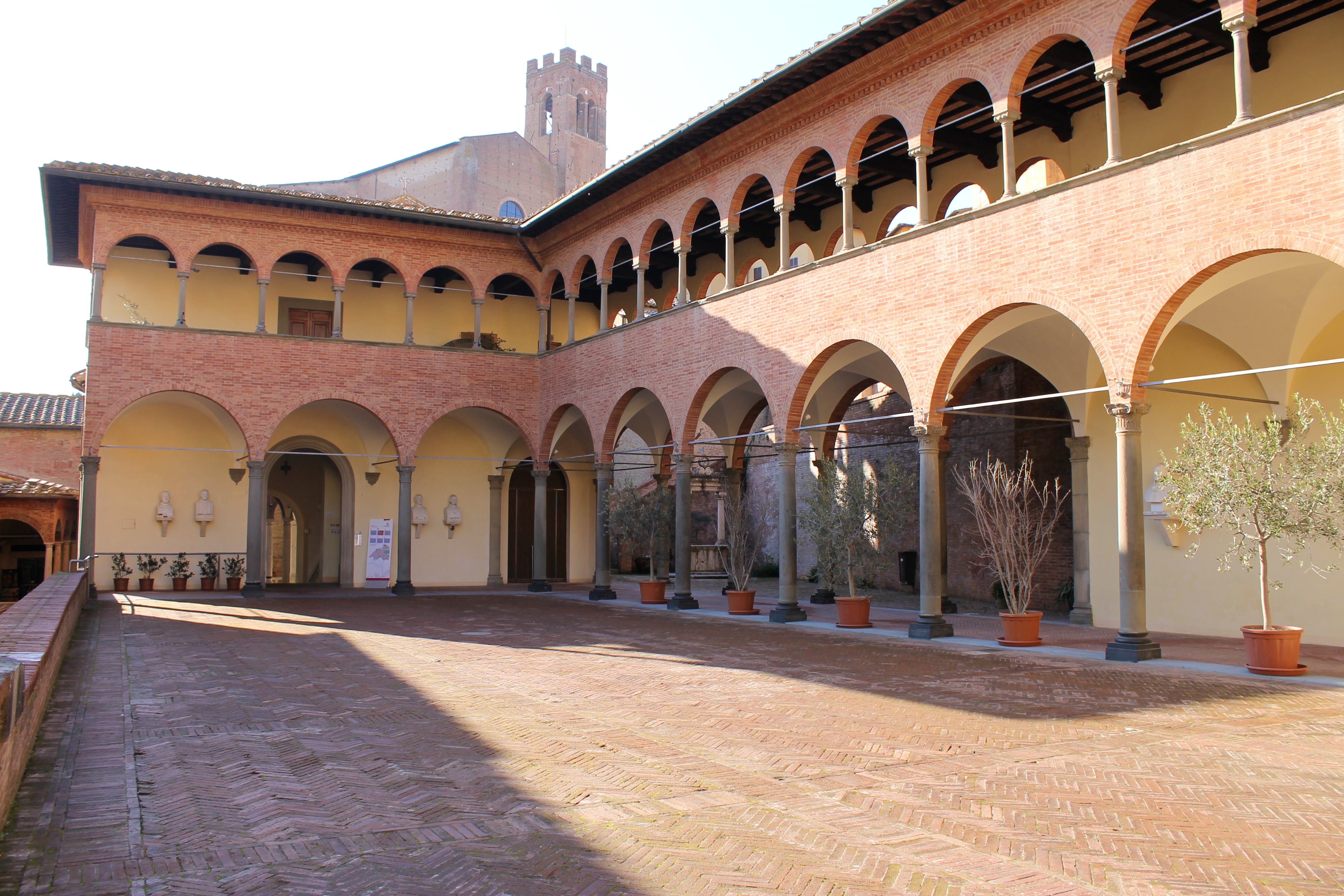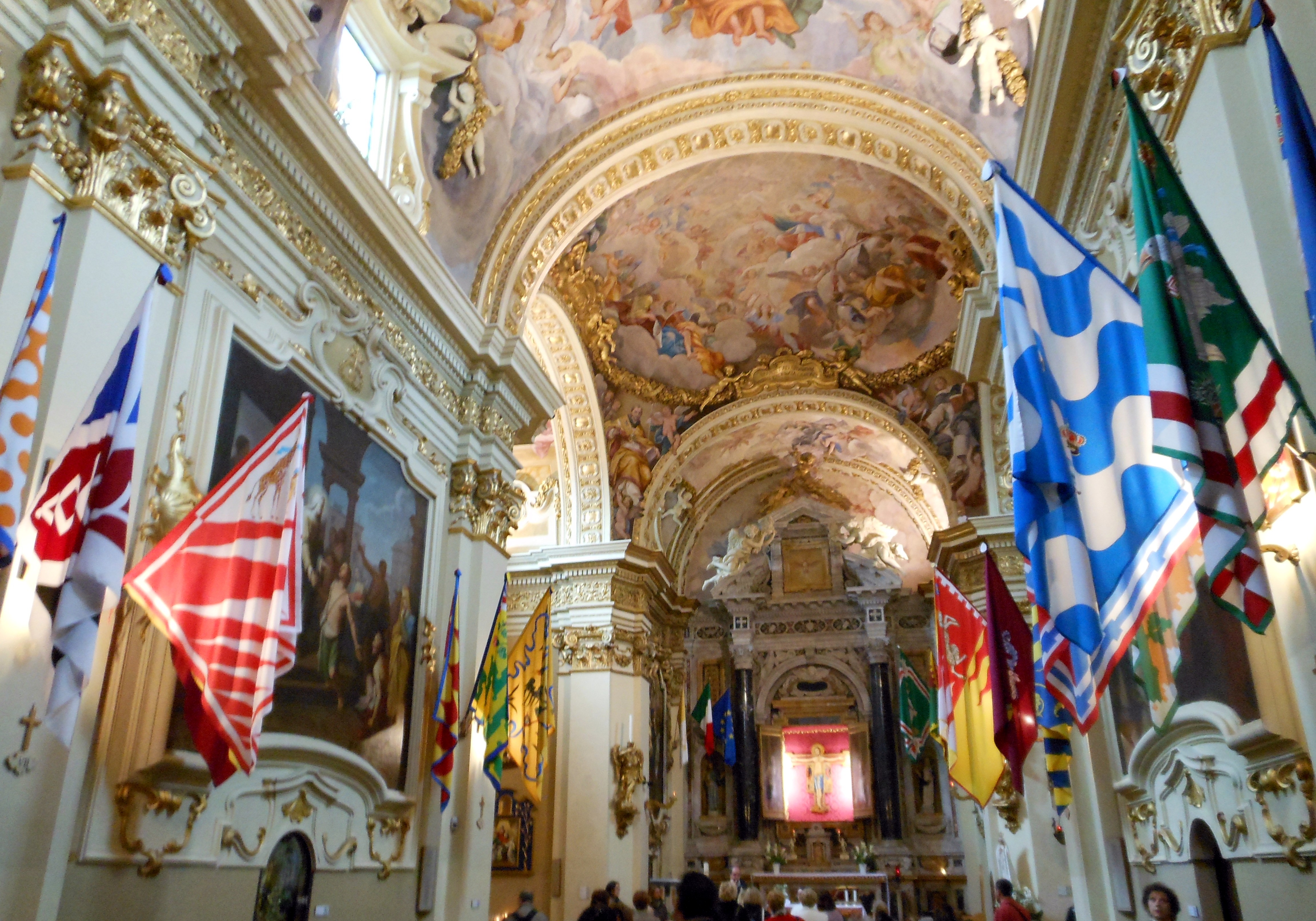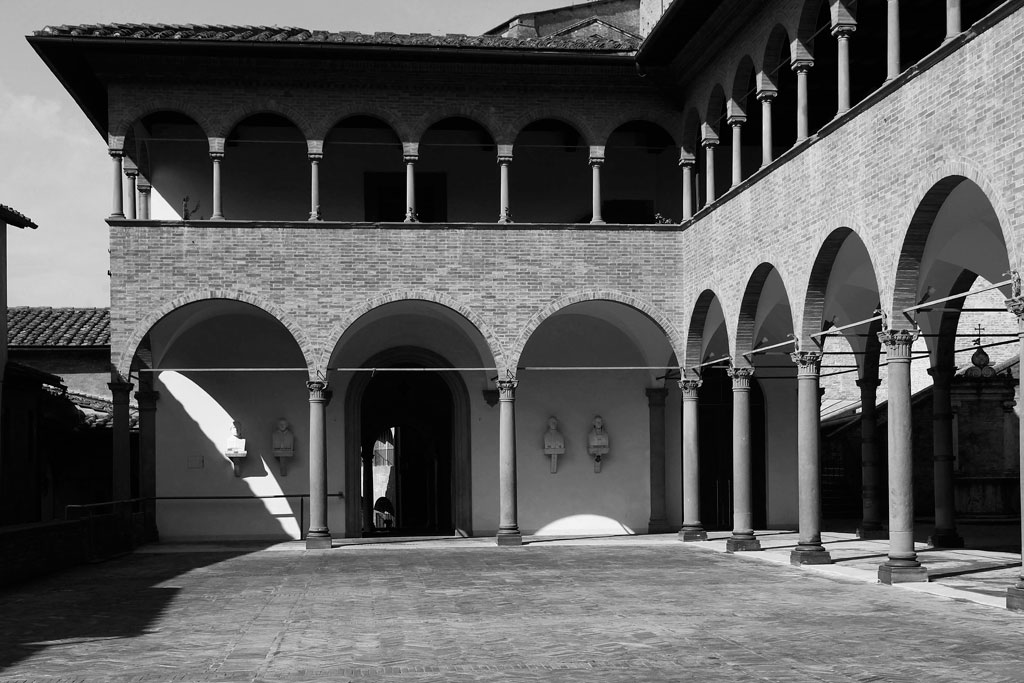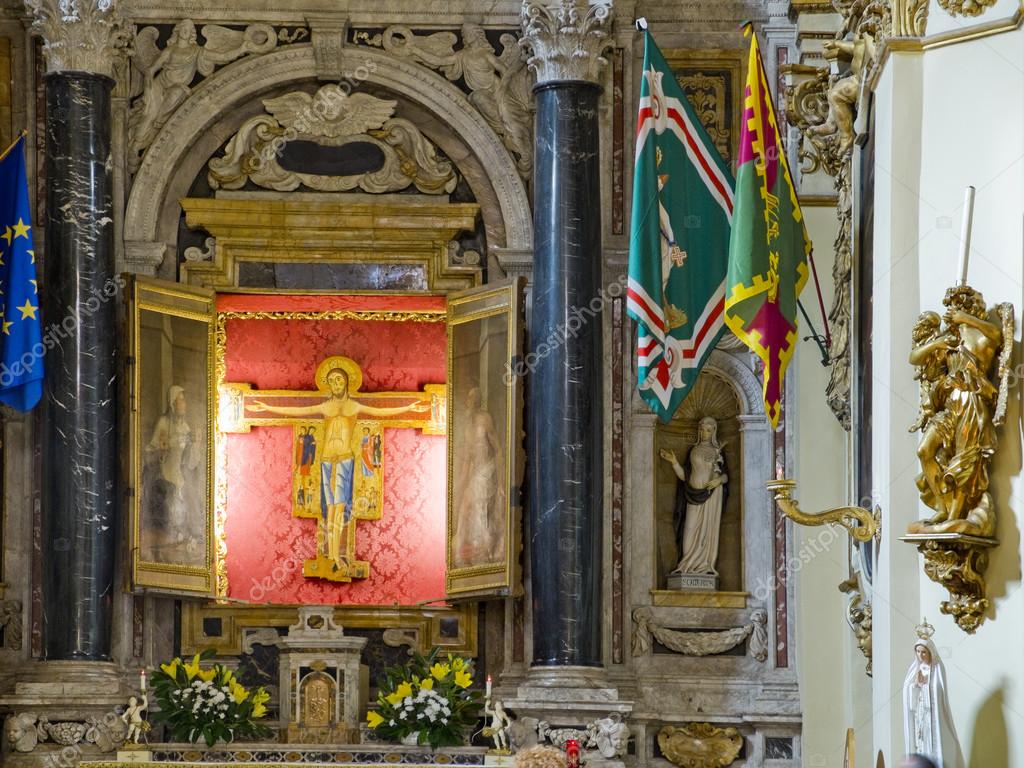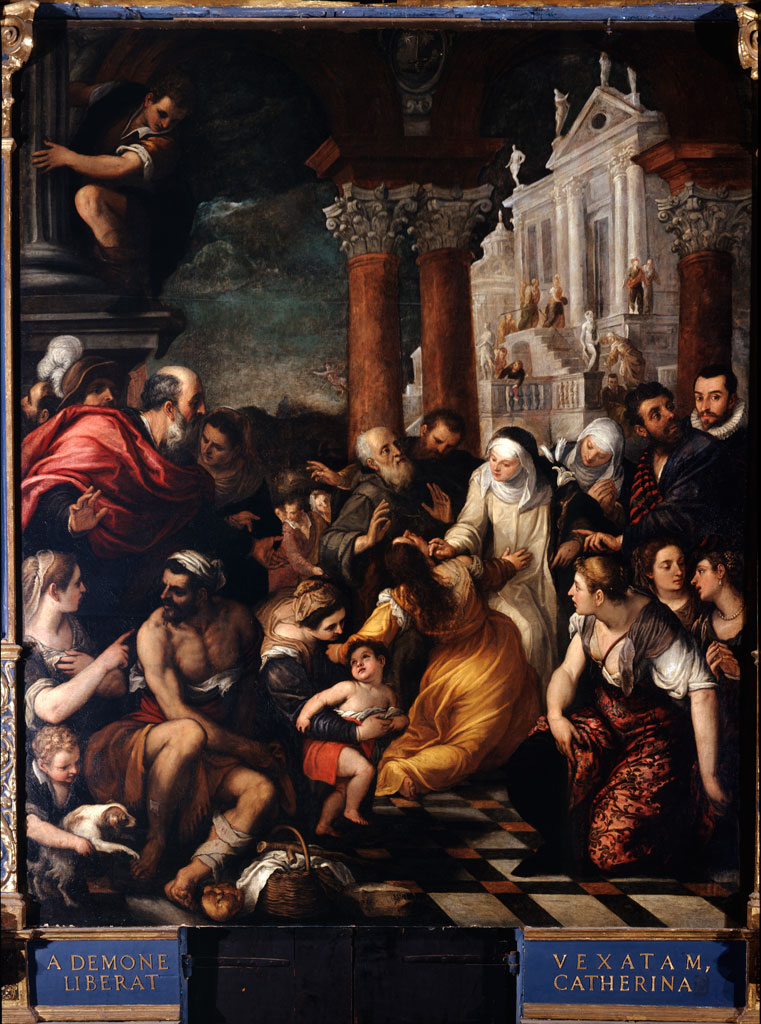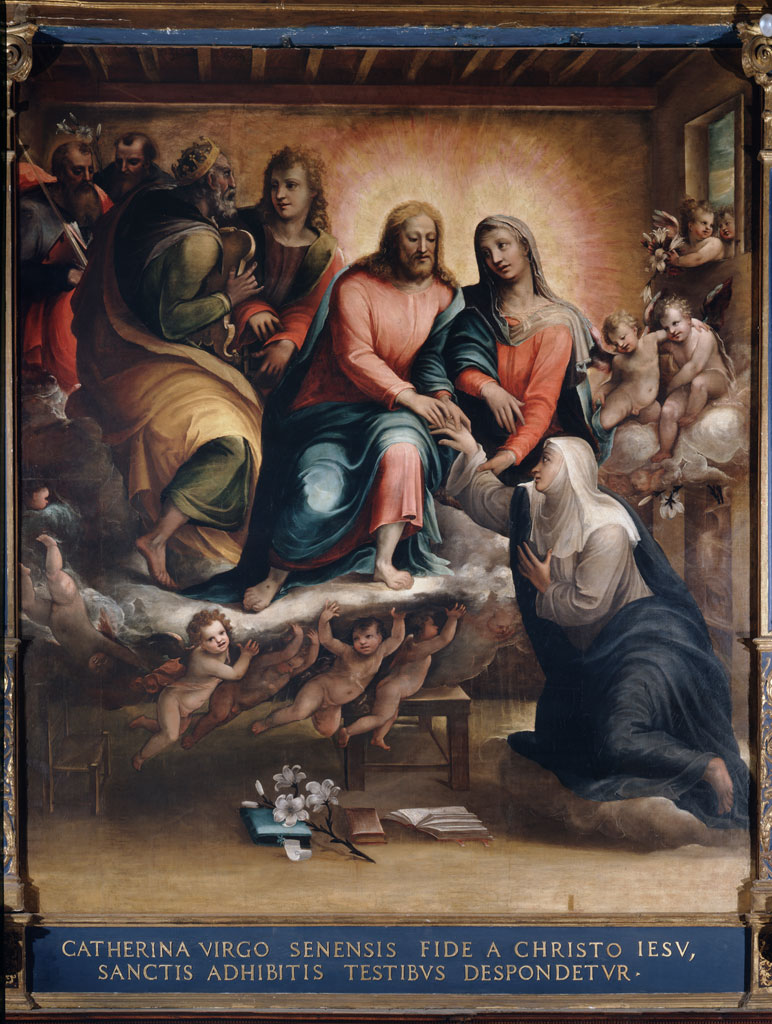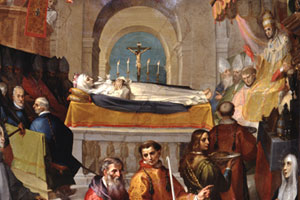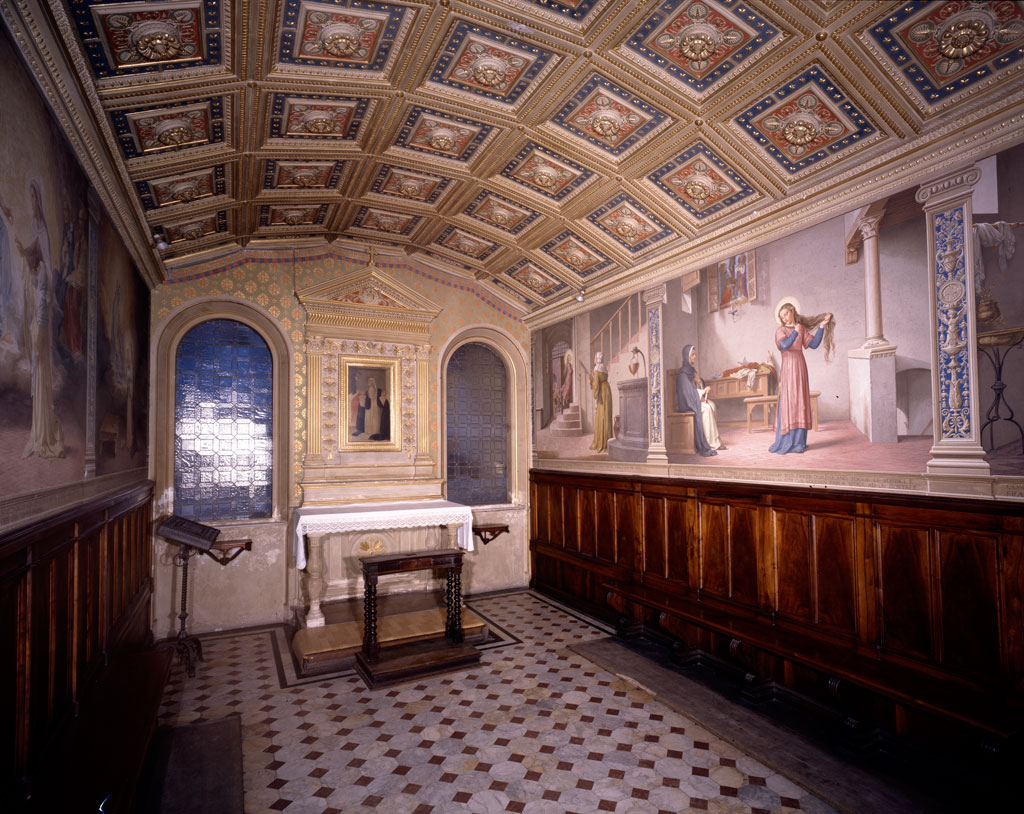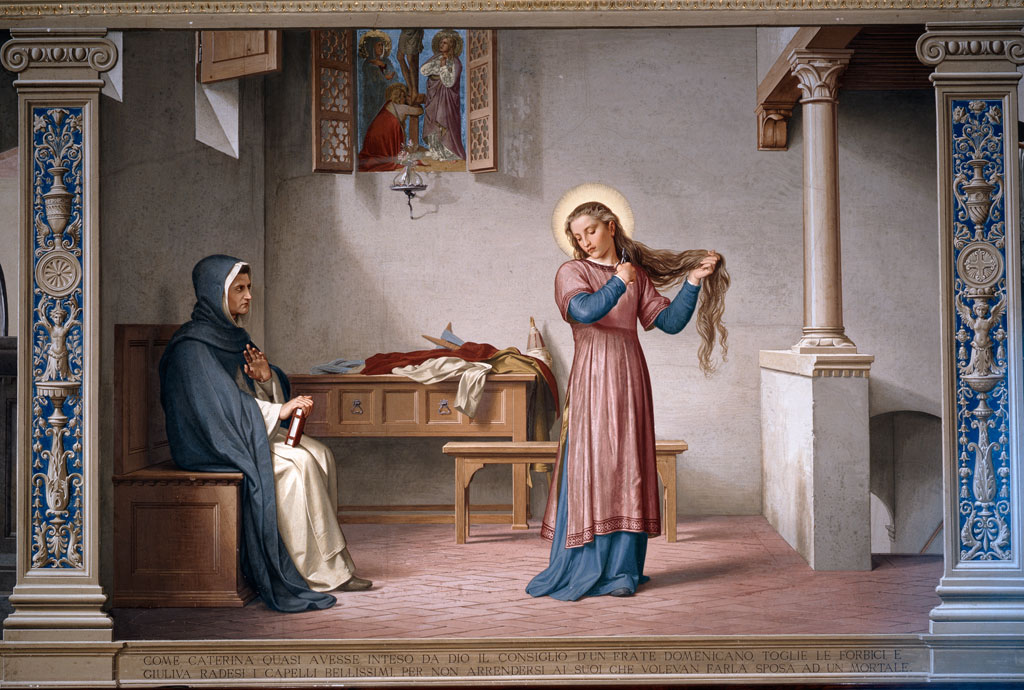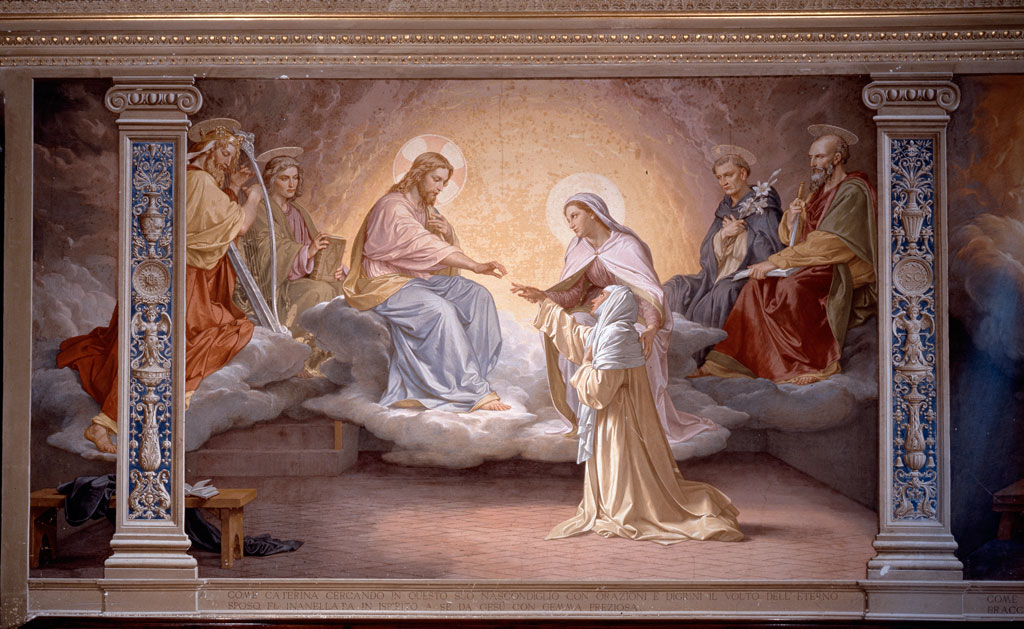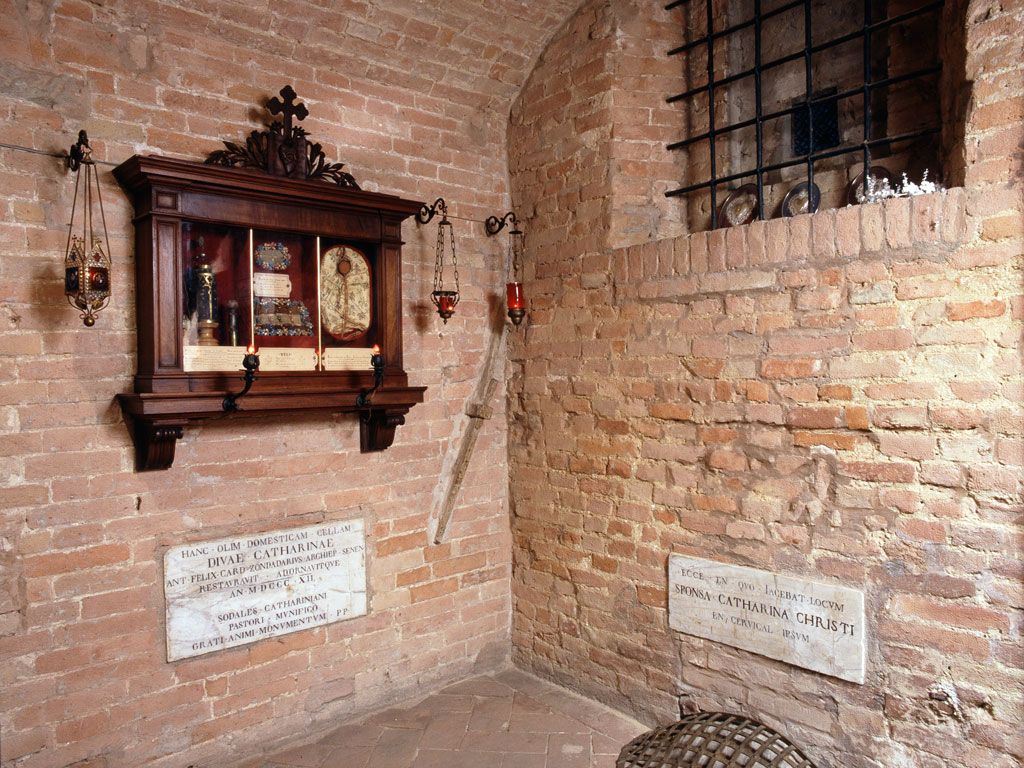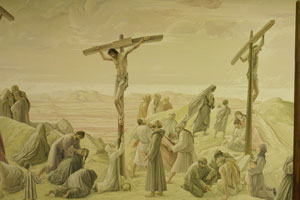The Shrine of the House of Saint Catherine
MAPThe Shrine of the House of Saint Catherine
Why is the place considered most representative of Saint Catherine her house, and not a convent? The answer lies in the fact that Catherine belonged to the Third Order of Saint Dominic. After taking the habit of a tertiary (called mantellata in Italian, “cloaked,” because she wore a cloak as part of her habit), Catherine continued to live in her family’s house, in keeping with the new way of living in consecration to God first introduced by Saint Francis and then adopted by Saint Dominic.
The institution of the Third Order was a response to the vocation of the many lay faithful, men and women, who wanted to pursue an intense Christian life inspired by the spirituality of the founders without living in a convent like the friars. Belonging to the Third Order offered the possibility of living the faith in the world. From the thirteenth century onwards, this proposal of ‘lay holiness’ captured a great number of adherents, thanks to the force of the message it contained: in every condition of life lies the opportunity to live the Gospel, and the call to holiness is not reserved for some, but is universal.
The story of Saint Catherine is an emblematic example: the fact of living her life inside the walls of her home and on the streets of the city rather than in a convent, and of being a lay sister rather than a nun, did not keep her from entering into deep communion with God and living according to His teachings.
The shrine complex consists of various sections. After crossing the Portico dei Comuni, you enter a small sixteenth-century open atrium, followed by another atrium. On the right side of this second atrium is the Church of the Crucifix and the Confessional Chapel, while on the other side is the Kitchen Oratory. Also on the left is a staircase down to the floor below, where the Oratory of the Bedroom is located.
History
Located in the Fontebranda district and belonging to the woolworkers guild, the house is divided into three levels. In the first half of the fourteenth century it was rented to Catherine’s father, the cloth-dyer Jacopo Benincasa, as a warehouse for dyeing cloth and as a home for his large family.
After the Benincasa family fell into decline, the property passed into the hands of another dyer, until in 1466, shortly after Catherine’s canonization, the commune of Siena decided to buy it, urged by the pleas of the inhabitants of Fontebranda who wanted the home of their saint to be always open for public veneration.
By that time, a lay confraternity dedicated to Catherine had already been founded; these were brotherhoods of the faithful who banded together for the purposes of charity, penance, and worship.
Thanks to the activity of these brothers, sustained by the many offerings from devotees, a series of initiatives began which has continued over the centuries, transforming the house into a real shrine, rich in works of art which retrace and render glory to the life of the saint.
Portico dei Comuni
This portico was created after Catherine was proclaimed patron saint of Italy on 19 June 1939, when it was decided to enlarge the entrance to the shrine by tearing down the church of Sant’Antonio in order to facilitate the passage of pilgrims and tourists who came to visit the sites of the saint’s presence.
Every municipality (comune in Italian) in Italy contributed the cost of one brick for its construction, hence the name, which means the “Portico of the Municipalities.” Work began in 1941 but was interrupted by the events of World War II; it was finished in 1947.
The only ancient element left in this area is the very fine travertine well, on the right, datable between the end of the fifteenth and beginning of the sixteenth century.
Under the portico are the busts of the popes whose papacy was connected with Saint Catherine: Pius II, the Sienese Enea Silvio Piccolomini, who presided over her canonization on 29 June 1461; Pius IX, who proclaimed her co-patron saint of Rome for having brought the seat of the papacy back to Rome from Avignon; Pius XII, who made her a patron saint of Italy on 19 June 1939; John XXIII, who in 1961, on the five-hundredth anniversary of her canonization, urged all Christians to celebrate her; Paul VI, who proclaimed her a Doctor of the Universal Church in 1970, “considering the distinguished holiness of her life, her outstanding doctrine, and her beneficial effect on the life of the Church”; and finally John Paul II, who named her patron saint of Europe in 1999, because of her extraordinary efforts to bring peace to Europe in her time through her many exhortations to kings and rulers to build a society inspired by Christian values.
During the annual festivities in honor of Saint Catherine, a ceremony is held in the portico during which an Italian municipality or association donates the oil to keep the flame burning in a votive lamp placed inside the church of the Crucifix by the mothers of soldiers who died in World War II. All the terracotta and porcelain jars donated over the years to hold the oil for the lamp are on display in a niche located along the right side of the church and in the little bookshop to the left of the entrance atrium.
Church of the Crucifix
The importance of this church, and its very reason for being, lie in the presence of the wooden crucifix from which Saint Catherine received the stigmata (from the Greek stigma: mark), which are the wounds similar to those inflicted on Jesus Christ during His crucifixion.
This miraculous event took place in Pisa, where Catherine had gone in 1375 at Pope Gregory XI’s request for the purpose of persuading the lords of the city not to take part in the anti-papal league. In the Legenda Major, Raymond of Capua narrates that on 1 April of that year, while she was deep in prayer in the church of Santa Cristina, Catherine saw five blood-red rays, aimed at her hands, feet, and heart, streaming down from the crucifix in front of which she was kneeling. She immediately asked God for the stigmata to be invisible, and before the rays could reach her they changed color, becoming resplendent with light. They remained visible only to the saint for the rest of her life, miraculously appearing at the moment of her death. The validity of Catherine’s stigmata was only recognized officially in 1623 by Pope Urban VIII, after a debate lasting about two centuries.
As had happened for Saint Francis of Assisi, who was the first saint to receive the stigmata, for Catherine too the episode marked the culmination of her spiritual journey and represents her identification with Jesus Christ: Catherine became in all things conformed to the crucified Lord, and like Him burned with the same desire for mankind’s salvation. Her request that the stigmata be invisible responds to her refusal to ‘make a spectacle’ of the miraculous event, in keeping with the extraordinary humility that characterized her whole life.
Right after Catherine’s death, the people of Siena wanted to possess the crucifix that had made her a perfect icon of Christ’s love; after many attempts, the Confraternity devoted to her was successful, and in 1565 the wooden cross was brought to Siena and placed in the Kitchen Oratory.
As time passed, however, it began to be thought that a more fitting setting should be found for it, big enough to permit it to be venerated properly. The only available space was the area in front of the Kitchen Oratory, traditionally thought to be the Benincasa family’s vegetable garden. Right here, between 1614 and 1623, the Church of the Crucifix was built in the baroque style, and its decoration continued for more than a century.
The crucifix, painted on wood by an artist of the Pisan school around the end of the thirteenth century, was placed in the center of the high altar, the most prominent position in the church, on 21 May 1623, after a solemn procession by way of all the major places of worship in Siena. It is enclosed in a frame with two doors, on the inner side of which are the images of Saint Catherine and the penitent Saint Jerome, both by the Sienese painter Bartolomeo Neroni, known as Riccio.
The numerous paintings hanging on the walls retrace significant moments in Catherine’s life, stressing in particular the extraordinary results she obtained in favor of the Church in the political sphere by bringing the seat of the papacy back to Rome from Avignon, thus putting an end to what was called the “Babylonian captivity” (1308-1377), and re-establishing the peace between Florence and the Papal State, at war with each other for a long time. The exceptional nature of the saint’s operations, intuited already by her contemporaries and then understood more fully in the course of the centuries, shows what a human being, and what is more a woman, and almost illiterate, can do when she knows how to listen to the voice of God and generously consecrates her life to Him.
Three of the four large canvases occupying the nave of the church are devoted precisely to this particular aspect of Catherine’s experience. Starting from the entrance, the first painting on the right wall shows Pope Gregory XI’s Return to Rome, painted by Niccolò Franchini and dated 1769, next to the canvas showing Catherine Exhorting Gregory XI to Return to Rome, by the Bolognese artist Alessandro Calvi, known as Sordino.
On the opposite wall we see Saint Catherine Assaulted by Florentine Soldiers, painted by Galgano Perpignani in 1765, which evokes one of the moments in her work of making peace between Florence and the papacy.
The fourth canvas, painted by Liborio Guerrini in 1777, shows The Charity of Saint Catherine, with the saint surrounded by the poor as she hands out bread to them. In reality, the Legenda Major recounts that she usually did her charitable acts at night, leaving her contributions outside the door of the homes of indigent families, in keeping with the Gospel teaching that almsgiving should be hidden and those who practice it should not call attention to themselves.
The paintings on the two altars on the sides of the transept show, on the right, once again Saint Catherine before Gregory XI at Avignon, an eighteenth-century work by Sebastiano Conca, and on the left Saint Catherine Welcomed into Paradise by Our Lady and Presented to Jesus Christ, a canvas painted by Rutilio and Domenico Manetti in 1638. In the painting, Catherine is shown according to an unusual iconography, wearing a white habit without the usual black cloak and with a triple crown on her head. This detail recalls an episode in the Legenda Major, in which a woman named Semia, after receiving a miracle from Catherine, in a dream saw the saint in paradise with three crowns on her head – one of gold, one of silver with red highlights, and one of gold studded with precious stones – which refer to the so-called triple crown halo (or corona aureola accidentalis), the symbol of virginity, martyrdom, and doctrine. The painting, made just a few years after the recognition of the stigmata, can be considered one of the first depictions on canvas of the glorification of the saint.
Still in the left transept, on the left-hand wall, is a standard portraying Saint Catherine Receiving the Stigmata from the Crucifix, painted by Rutilio Manetti in 1630, commissioned by the Confraternity of Saint Catherine. Next to the altar is a little niche which holds a reliquary containing a fragment of her shoulder blade.
On either side of the chancel are two paintings by Giuseppe Nicola Nasini showing, on the left, The Ecstasy of Saint Catherine, and on the right The Saint Writing under the Inspiration of Saint John the Evangelist and Saint Thomas Aquinas, the Dominican theologian whose teachings inspired her work. Nasini also painted the frescoes on the dome and ceiling between 1701 and 1703, showing The Glorification and Exaltation of Saint Catherine, in which she is welcomed into Paradise and made a participant in the heavenly glory.
Kitchen Oratory
This room encompasses the space once occupied by the Benincasa family’s kitchen, the fulcrum of domestic life. Visible through the grille under the altar are the remnants of the ancient fireplace on the opposite wall; in this very fireplace, while a fire was burning, Catherine fell during one of her ecstatic trances, but she was miraculously unharmed. The saint spent the first phase of her life within the walls of her home, amid unceasing prayer, penance, and moments of contemplation and conversation with the Eternal Father, until the moment when God called her to concrete action in support of the Church and the papacy, culminating in her trip to Avignon, the greatest diplomatic initiative of the fourteenth century in Europe, whose result was the return of the papal seat to Rome.
In 1482-1483, about a century after Catherine’s death, the Confraternity of Saint Catherine chose this spot as the meeting place for its members, who soon thereafter placed the panel painted in 1496 by the Sienese artist Bernardino Fungai on the back wall above the altar. The painting, in all probability commissioned by the Saracini family, one of the most important in Siena, presents in the central compartment the episode of Catherine receiving the stigmata, the most sublime moment of her spiritual journey. At the time that the picture was painted, the crucifix from which Catherine received the stigmata (now in the church across from the oratory) was still in Pisa. It was brought to Siena several decades later, in 1565, and very few Sienese had seen it before then. This explains why Fungai visualizes the crucifix as a sculpture rather than the painted cross it really is. The altarpiece has a predella with scenes from the life of Saint Catherine and two side wings holding the figures of Saint Dominic and Saint Jerome, also by Fungai. The upper section with God the Father and two prophets was added some decades later, in 1567, by the Sienese painter Bartolomeo Neroni, known as Riccio.
Right around the middle of the sixteenth century, the Confraternity decided to enlarge the Oratory and to begin furnishing and decorating it under the guidance of Riccio, who was able to give the room a homogeneous, unified character. Besides several paintings, Riccio was also responsible for the design of the beautiful blue and gold coffered ceiling (made by the carver Bastiano di Girolamo) and the rich wood paneling on the walls, which frames and ties together the various canvases. The space is completed by a wooden choir and by Renaissance polychrome majolica tiles on the floor, many of which have unfortunately worn away and been replaced over time. In order to preserve what is left of this rare and valuable floor, the oratory now has a raised transparent platform along the sides which enables visitors to walk around it without causing any further damage.
The numerous canvases adorning the walls, commissioned to various artists by the confraternity, depict episodes from Catherine’s life, drawn mainly from Raymond of Capua’s Legenda Major. In the corners are portrayed four Sienese saints and blessed.
Left wall
Entering the room, on the left, preceded by the canvas of Blessed Giovanni Colombini by Alessandro Casolani, you see the first of the three large scenes that decorate the wall, painted by Pietro Sorri in 1587 and featuring Catherine Freeing a Girl Possessed by a Devil. The saint herself was tempted by the devil on several occasions, but, with the help of divine grace, she never yielded to his attacks.
The next painting, by Cristoforo Roncalli, known as Pomarancio, dated 1582, shows Saint Catherine miraculously receiving Holy Communion. The scene takes place in the basilica of San Domenico, where during Mass, at the moment when the priest breaks the Bread, Jesus Christ manifested Himself to Catherine and gave Himself to her, flooding her with a ray of light. At various times during her life, Saint Catherine received the Eucharist directly from Jesus. In contrast with the custom of her time, Catherine was used to taking Communion every day, turning to her confessor with the words, “Father, I’m hungry.” She considered the consecrated Host to be her soul’s nourishment and an extraordinary gift of love which God renews to us constantly as fuel for our journey of faith.
The third painting, by Lattanzio Bonastri around 1580, bears witness to Catherine’s mercy towards the imprisoned and those sentenced to death, whom she visited periodically, always seeking the conversion of their souls. In this scene, the saint is shown as she asks the Lord for salvation for two criminals being led to the scaffold, amid the torments inflicted on them by a host of demons. Higher up, the clouds part and Jesus appears with the Cross on His shoulders, an evident reference to His Passion and an allusion to the suffering the two men are about to undergo. The story in the Legenda Major which is the source for this picture continues with the repentance and conversion of the men, who face death courageously, accepting the Lord’s will and making it their own.
The series of works on the left wall concludes with a panel painting of Blessed Ambrogio Sansedoni by Gaetano Marinelli, dated 1872.
Back wall
Occupied in the center by the altarpiece by Fungai, the wall holds on the sides two paintings made by Riccio not long before he died (1571) and perhaps completed by Arcangelo Salimbeni. The one on the left shows Jesus holding out to Catherine the little cross the saint had given Him when He was in the guise of a beggar; the one on the right presents the saint giving her cloak to Jesus, who appears as a pilgrim. These are just two of the miraculous events which studded Saint Catherine’s life and testify to her outstanding spirit of charity. They are also depicted in two canvases inside the basilica of San Domenico, in the Chapel of the Vaults, where these episodes took place.
Right wall
Starting from the back, this wall presents a panel painting of another great Sienese saint, Bernardine, painted by Pietro Aldi in 1872.
Next is the first of three large scenes, begun by Riccio and finished by Arcangelo Salimbeni in 1578, whose subject is The Mystical Marriage of Saint Catherine, a testament to her profound union with Christ. The depiction reflects the version of the event reported in the Legenda Major: during the night of Shrove Tuesday, while in the streets the people were celebrating Carnival, Catherine, closed up in her room, was deep in prayer. Suddenly the Lord and Our Lady appeared to her, accompanied by Saint Dominic, Saint Paul, Saint John the Evangelist, and King David playing the lyre. Our Lady took Catherine’s right hand and held it out to Christ, who placed a precious ring on her finger, marrying her in the faith. In this episode we grasp the vital center of Catherine’s religiousness: Christ is, for her, like a husband, to whom she is joined in a relationship of communion and fidelity. He is the good loved above all other goods.
The scene right after this one puts the accent on Catherine’s ‘political’ activity; the juxtaposition of the two paintings can be considered emblematic of the two fundamental aspects of her life story. For she was not only a great contemplative who lived the most sublime mystical experiences (such as the Marriage just observed), but at the same time a woman of action engaging her gifts of intelligence, heart, and will in numerous social works, in efforts to make peace among peoples, and in diplomatic negotiations between the papacy and governments. The scene, painted by Pomarancio in 1582-1583, shows Catherine in Discussion with Pope Gregory XI, which took place in Avignon in the presence of the College of Cardinals, during which the saint persuaded the pope to bring the seat of the papacy back to Rome.
The third scene, painted by Alessandro Casolani between 1582 and 1583, presents an analogous subject, Pope Urban VI Given the Keys to Castel Sant’Angelo, after Catherine had brought the people back to obedience to the pope. The canvas refers to the Great Western Schism which occurred in September 1378; when the French cardinals elected the antipope Clement VII, Catherine became a supporter of Urban VI, exhorting everyone to recognize his authority as the legitimate successor of the Apostle Peter. As can be read over and over again in her Epistolary, the pope, the priests and, more generally speaking, the Church represented for her Jesus Christ on earth, and as such they were owed love and obedience, despite any human ‘shortcomings’ they might have.
The series of paintings on the right wall is concluded by the canvas of Blessed Andrea Gallerani by Alessandro Casolani.
Entrance wall
The wall opposite the altar, on either side of which are the two doors into the room, is occupied in its center section by a large niche, ordered built by a member of the Tolomei family for the governors of the Confraternity, who sat here during meetings. Inside it, Francesco Vanni painted in oils, in 1600, The Canonization of Saint Catherine, illustrating the solemn ceremony presided over by Pope Pius II in the presence of the saint’s mortal remains. To the sides of this composition are Saint Bernard and Blessed Nera Tolomei, two Sienese religious who lived between the 13th and 14th centuries. Their presence in the picture is due to the fact that they belonged to the same family as the man who paid for the painting.
To the sides of the niche, above the doors leading into the Oratory, are four paintings. The one at upper left, by Rutilio Manetti and his workshop, dated around 1635, shows Catherine as a Young Girl Surprised by her Father Praying with the Dove of the Holy Spirit above her Head, an episode that marked the moment when her family, who had opposed her vocation until then, decided to leave her free to follow her own path. Below it is a canvas by Pietro Sorri showing Jesus Offering Catherine Two Crowns, one of gold and the other of thorns. The saint chooses the second one, affirming in this way her will to conform to the Passion of Our Lord.
The last two canvases, placed to the right of the niche, present in the top one Catherine Praying in Front of Jesus Tied to the Pillar, painted by Rutilio Manetti and his workshop in 1635; the one beneath it shows Jesus Exchanging His Heart for Catherine’s, painted by Francesco Vanni in 1585, which testifies once again to her profound union with the Lord and her effort to be in total harmony with the feelings of Christ’s heart, in order to love God and her neighbor as Christ Himself loves.
Oratory of the Bedroom
Going down the stairs on the left side of the entrance atrium, we come to the Oratory of the Bedroom, which encompasses the small cubicle where Catherine used to pray and to rest; inside it, protected by an iron grille, is the stone where she would lay her head.
This is the space most intimately tied with the first phase of the saint’s life, where, little more than a child, she would withdraw in isolation, devoted to contemplation and penance. Here, at the young age of seven, she retreated into herself in order to learn to know Christ and then opened up to spread the grace of God throughout the entire mystic body of Christ which is the Church. Thus, from the beginning Catherine’s body, subjected to harsh deprivation, drew in and became smaller. Even the space where she moved about is marked by a progressive shrinkage: she closed herself up in her house, then did not come out of her room, and finally walled herself inside a spiritual cell constructed in the inner reaches of her soul, where she engaged in constant dialogue with Jesus. At this point Catherine has nothing, is nothing, but precisely because of this she can be completely reshaped by divine grace. Her new body does not function according to the laws of biology, but according to the directives of the Absolute: it feeds on the food of the Eucharist and the blood that pours from Christ’s side, and identifies fully with Him to the point of taking on His wounds, the stigmata. It receives extraordinary abilities: levitation, invulnerability to fire, the gift of working miracles. Her soul goes beyond the boundaries of her body, and comes out of it in ecstasy, then goes back in so she can go out into the streets of the world. Catherine leaves her cell, then her house, and then Siena, to bring to all the love of Christ that she has come to know in intimacy.
The oratory is a small room which was completely remodeled in 1874 according to plans drawn up by the architect Pietro Marchetti, leaving only the little cubicle the way it was. The back wall holds a small altar above which is the oldest art work in the oratory: the beautiful panel paining of Saint Catherine Receiving the Stigmata, made by Girolamo di Benvenuto at the beginning of the sixteenth century.
The walls were frescoed by Alessandro Franchi, with the collaboration of Gaetano Marinelli, in 1896. The cycle, inspired by the Legenda major by Raymond of Capua, begins at the far end of the right-hand wall.
Right wall
The first episode shows Lapa, Catherine’s mother, watching her little daughter as she climbs the stairs suspended mid-air, thus realizing that this girl was different from her other children. Catherine’s early vocation was the cause of great conflict with her family, especially her mother, who judged Catherine’s childish behavior as fanaticism, trying every way she could to put an end to it.
She decided, first of all, to make Catherine get married; after various arguments, Catherine reiterated the irrevocable nature of her decision by cutting off her hair, a very unseemly act for a girl at the time. The next fresco shows the girl cutting off a long tress in the presence of the Dominican friar Tommaso della Fonte, whose words had pushed her to make this gesture.
After that episode, her mother tried to break Catherine down by forcing her to do the heaviest housework and preventing her from recollection and prayer; she also decided to take away her personal bedroom and make her sleep with one of her siblings, hoping that, without a place where she could feed her ‘daydreams,’ Catherine would sooner or later come to her senses. The young girl did not rebel, but obeyed meekly, doing all the work that was forced on her and substituting for her physical cell a spiritual cell in which she continued constantly her dialogue with Christ.
Her family’s persecution finally stopped when her father Jacopo came upon Catherine by surprise as she prayed with the dove of the Holy Spirit flying around her head, an episode shown in the third and last fresco on the wall. At this point he was convinced of the authenticity of his daughter’s vocation, and forced his wife to surrender in the face of Catherine’s will to consecrate herself totally to Christ.
The frescoes continue on the wall next to the cubicle: on the left is Saint Catherine Giving her Cloak to Jesus Christ in the Guise of a Poor Man, and on the right Jesus Offering Catherine a Crown of Gold and a Crown of Thorns. Catherine takes the crown of thorns, choosing a life made up of penance, charity to others, and prayer.
LEFT WALL
The left wall of the oratory is taken up by the last two scenes: the first depicts The Mystical Marriage of Saint Catherine, in which the saint gives herself totally to Christ, while the second shows her Mystic Motherhood. This scene refers to an episode reported by Raymond of Capua in the Legenda Major: on Christmas Eve, Our Lady appeared to Catherine and placed the Baby Jesus in her arms, in this way making her a ‘mother.’ The saint had a maternal relationship with her disciples, to the point that for her followers of yesterday and today she was, and continues to be, “mother and teacher.”
THE CUBICLE
Visible through a grille on the right of the entrance to the oratory, the cubicle holds not only the stone used by Catherine as a support for her head in her rare moments of rest, but also some important relics of the saint, kept in a case hanging on the left wall: the round handle of the walking stick she used to support herself, the jar where she put herbal essences to ease the pains of the sick in the Santa Maria della Scala hospital, the lantern she used for night visits, part of her veil, and the silk bag in which her head was placed when it was brought to Siena from Rome in 1384.
In front of the grille is a marble statue of Saint Catherine in Ecstasy, sculpted in 1940 by Pietro Repossi, and behind this is a small cabinet containing the books listing the names of the members of the International Association of “Caterinati,” the followers of Saint Catherine. On the wall above are some ex votos donated by faithful who received grace after praying to Saint Catherine.
Confessional Chapel
Inaugurated in April 2006, this chapel is conceived as a space for celebrating the sacrament of Repentance, therefore silence and recollection prevail here. The plan by the Sienese architects Betti, Fineschi, and Lamoretti is based on the idea of the centrality of a luminous oculus of clear glass that sheds light on the room from above, just as the Grace of God is light that flows from His mercy granted in the sacrament.
To the right of the entrance is a holy water font by the artist Alberto Inglesi, rich in Christian symbolism: the ship represents the Church and the water in the font is a remembrance of baptism. The ship/Church moves on the waves of history; inside it, the living water of baptism and the Grace of Christ is offered.
The main wall of the room holds a fresco by the Sienese artist Ezio Pollai. In the center is the scene of Christ’s crucifixion, according to the symbolic reading of it given by the Gospel of Saint John: the inscription on the cross (in three languages: Hebrew, Greek, and Latin) attests that Christ died for all, addressing his message of love to all peoples and all cultures; Jesus’ bent head expresses his free will to adhere to the offering of love; the pose of the body joined to the cross does not symbolize the drama of the event so much as the regal enthronement of Christ. The cross, in John’s Gospel, is not a scaffold but a throne from which Christ reigns: “And when I am lifted up from the earth I shall draw all people to myself” (John 12:32). Mankind’s lack of comprehension of the death of the Son of God and refusal of His message of love is stressed by the artist by having the other two men crucified beside the Lord turn their backs in a sign of opposition. Diametrically opposed to this gesture of refusal is the adoring pose of Saint Catherine, who makes the mystery of crucified Love her own by embracing the wood of the cross. Lower down, Saint Francis lifts his eyes towards the Lord, in a mystic vision. On the left side of the cross is the Virgin Mary, torn by grief, with the beloved disciple John holding her head. To the right of the cross of Jesus is the scene of the soldiers gambling for Christ’s clothes: the angry attitude with which the clothes are fought over shows the complete insensitivity to the mystery of the Son of God’s gift of his life. At the base of the cross of the man on the right, the human experience of suffering is described by means of a female figure covering her face; slightly higher up is the image of famine, symbolized by the emaciated body of a child carried on the shoulders of a woman with African features.
To the left of the Crucifixion are shown two Gospel episodes which are among the most important for understanding God’s infinite love. The first presents the parable of the “Good Samaritan” (Luke 10:29-37) who, getting off his horse, tends to a man beaten and robbed by the roadside, while a short distance away the priest and Levite are so wrapped up in religious and theological matters that they pay no attention to the needs of the poor victim, thus failing to put into concrete action the contents of the faith they are discussing. The other episode is the one of the adulteress pardoned by the Lord (John 8:1-11), demonstrating God’s great mercy.
Beside the cross on the right are two antithetical scenes: the first is the one of the hired man who does not take care of the flock entrusted to him, but runs away at the sight of the wolf (see John 10:12ff). The hired man represents the man who has not absorbed the message of love of the cross: the need for a gratuitous love towards others, a love that gives one’s life and does not use other people. The other scene, in antithesis with the first, is the parable of the “Prodigal Son” or of the “Merciful Father” (see Luke 15:11-32), which tells the story of a young man who leaves his father’s home and then, falling into a state of neediness, decides to go back; he is welcomed lovingly and thoughtfully by his father, who expresses all the joyous mercy of God towards the children who return to Him even though aware of the error of their ways. Note how, with poetic sensitivity. The artist has depicted the merciful father with the facial features of Blessed John Paul II, affirming also in this way the identity of the true shepherd as opposed to the hired man.
The right corner of this grand fresco is devoted to the appearance of the Risen Christ to the apostles on Easter evening. The scene aims at communicating the effect produced by the crucifixion: the gift of life and the remission of sins which the Risen Christ dispenses freely. The cross is not Jesus’ last word, but is like the grain of wheat that has to die in order to bear fruit (John 12:24).





